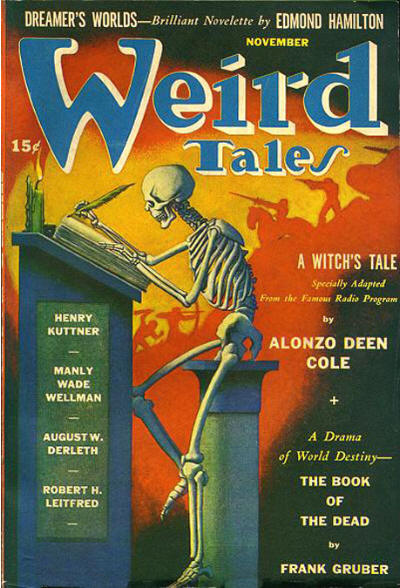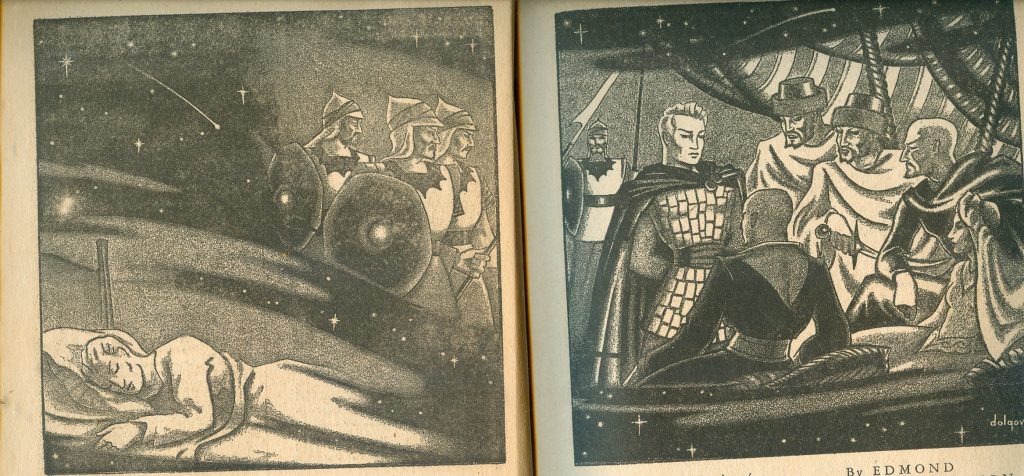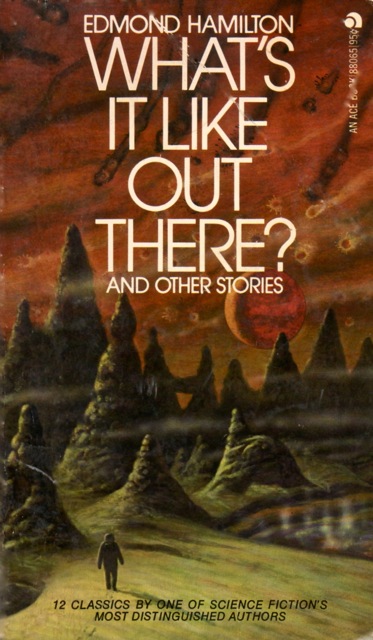 Edmond Hamilton (1904-1977) was the main writer of science fiction for Weird Tales magazine in the late 1920s and 1930s. Or rather I should say, the best science fiction writer for Weird Tales. He was an early writer of space opera alongside J. Schlossel and Edward E. Smith for the pulp magazines.
Edmond Hamilton (1904-1977) was the main writer of science fiction for Weird Tales magazine in the late 1920s and 1930s. Or rather I should say, the best science fiction writer for Weird Tales. He was an early writer of space opera alongside J. Schlossel and Edward E. Smith for the pulp magazines.
Hamilton did have some forays into sword and planet fiction. He had the three adventures of Stuart Merrick in Magic Carpet and Weird Tales magazines in the 1930s. A one off story was built around the idea of two men on different worlds sharing each other’s existence as dreams.
The story was “Dreamer’s Worlds” that appeared in the November 1941 issue of Weird Tales. It starts with Khal Kan, Prince of Jotan, scouting out a Dry-lander tribe. He is accompanied by little wizened Zoor and squat Brusul. Hamilton liked ensemble casts in his stories.
Khal Kan is not given much description outside he is tall, young with a “hard, merry face.”
The trio enters the Dry-lander tent town posing to be wandering mercenaries. Khal Kan wanted to get a look at the king’s daughter, Golden Wings. Their cover is blown and Khal Kan mouths off to Golden Wings. She gives him a whipping and has he and his companions tied up. Zoor manages to use a hidden flat blade in his shoe to cut himself and his companions free from their bonds.
Khal Kan is not content with merely escaping. He abducts and carries of Golden Wings. Pursuit is fast approaching so Khal Kan frees Golden Wings. She chooses to join Khal Kan and they are married in the Dry-lander fashion.
Khal Kan and his companions had been reconnoitering looking for a horde of green barbarians, the Bunts, led by his father’s treacherous brother, Egir.
Interspersed in the story are interludes of nebbish Henry Stevens of Illinois, an insurance company worker. He dreams of the adventures of Khal Kan of the planet Thar every night. Khal Kan has dreams of Stevens’ humdrum life. Henry is getting into trouble at work having difficulty concentrating while worried about Khal Kan.
Khal Kan and Golden Wings ride to battle the Bunt horde. Things do not go well as the Bunts use poison arrows to devastate the Jotan army. Khal’s father is killed during the battle and he has the army retreat while he fights in the rear guard.
Henry Stevens’ is beside himself on how to help Khal. He ends up poring over encyclopedias and repeating information over and over in the hope that Khal will remember from his dreams.
Khal has sulfur, saltpeter, and charcoal collected and mixed. The mixture is placed in metal vases, sealed with clay with wicks. The Jotan defenders use these grenades to devastate the green Bunts in their assault on the city.
Khal Kan orders a pursuit to get Egir. A poison arrow hits Khal but he manages to kill Egir, thus keeping Jotan safe. He dies giving orders for Brusul to be king. Back on Earth, Henry Stevens is found dead on a couch with Khal Kan’s smile on his face.

This is a competent piece of pulp. Boiler plate sword and planet built around a gimmick idea. Hamilton is competent with action and battle scenes. Characterization is minimal.
One bonus is an interior illustration by Boris Dolgov, my favorite Weird Tales artist.
There are probably enough sword and planet stories by Edmond Hamilton to fill out an old mass market paperback. I am surprised that Donald Wollheim at Ace Books did not do that in the mid-1960s when he was reprinting a lot of sword and planet fiction and Edmond Hamilton was writing for Ace.
“Dreamer’s Worlds” was reprinted in the Ace collection What’s It Like Out There? and Other Stories in 1974. This is a great collection. Twelve stories, most are from the 1940s including seven from Weird Tales. Some are from a cycle Hamilton wrote in the 1940s exploring myths of different cultures.

That WT cover by Hannes Bok is possibly the greatest in the entire original run.
Morgan, I bought that ppbk when it came out and asked Hamilton about the title story, “What’s It Like Out There?” which is really impressive. He said he wrote it in Florida during the trip there with Jack Williamson, I think (?). He couldn’t sell the story at that time; it was too realistic, a slice-of-life story taking place in the future with real characters and emotions. So he put it away and went back to space opera. Finally sold it in the fifties someplace when the genre started maturing a bit.